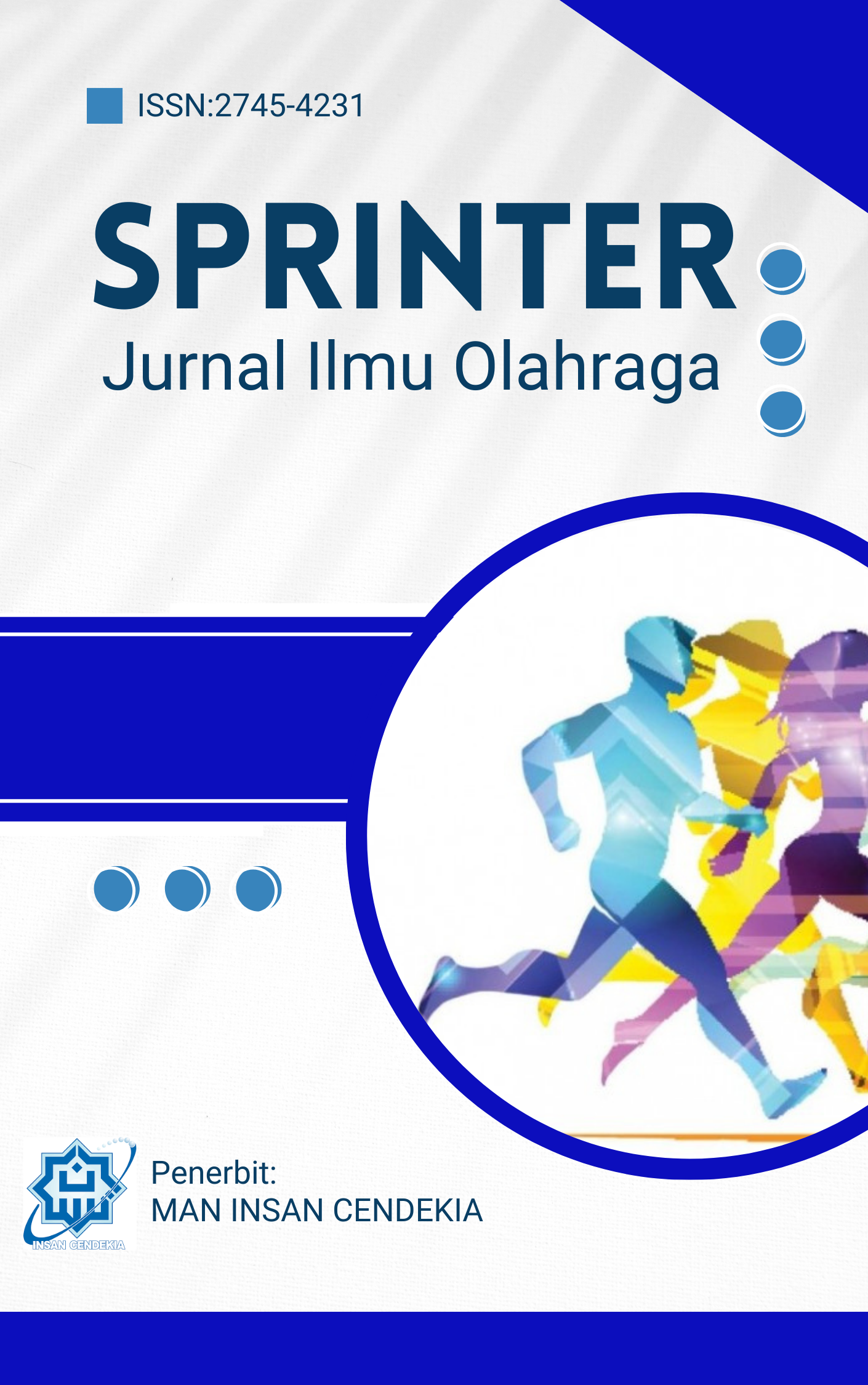Skrining Risiko Cedera pada Atlet Basket Senior dengan Metode Functional Movement Screen (FMS)
DOI:
https://doi.org/10.46838/spr.v6i2.758Keywords:
Athlete; Functional Movement Screen (FMS); Injury RiskAbstract
Decline in functional movement quality often occurs with age, particularly in individuals aged 32-50 years, who begin experience reduced flexibility, stability and motor control. Risk of injury can assessed by identifying the presence of compensatory movements or a loss of functional balance during physical activities. One of tools used for this pipose in Functional Movement Screen (FMS), which is effective in predicting sport-related injuries. This study to evaluate FMS scores in this age group and identifity potential injury risk based on screening results. With quantitative design and Functional Movement Screen (FMS) for method. The study involved 12 participans aged 32-50 years, and must to do seven standard FMS test : Deep Squat, Hurdle Step, In-Line Lunge, Shoulder Mobility, Active Straight Leg Raise, Trunk Stability Push-Up, and Rotary Stability. The results showed that 10 participants scored ≤14 points, which fall into the high-risk category. 2 participans scored between 15-18 points. The avarage FMS score at senior basketball athletes was 13.08 (high-risk category). It’s mean imbalance muscle function between upper and lower body movements, which may increase the likelihood of injury particularly among older athletes. Therefore, FMS serves as valuable screening tool to identify injury prevention strategies in senior basketball players.
References
Atmaja, A. N., Yuliastrid, D., Susanto, I. H., & Bakti, A. P. (2024). Tingkat pengetahuan anggota ukm karate unesa terhadap faktor pencegahan dan penanganan cedera. Jurnal Porkes, 7(1), 182–196. https://doi.org/10.29408/porkes.v7i1.22987
Chodzko-Zajko, W. J., Proctor, D. N., Fiatarone Singh, M. A., Minson, C. T., Nigg, C. R., Salem, G. J., & Skinner, J. S. (2009). Exercise and physical activity for older adults. Medicine and Science in Sports and Exercise, 41(7), 1510–1530. https://doi.org/10.1249/MSS.0b013e3181a0c95c
Chorba, R. S., Chorba, D. J., Bouillon, L. E., Overmyer, C. A., & Landis, J. A. (2010). Use of a functional movement screening tool to determine injury risk in female collegiate athletes. North American Journal of Sports Physical Therapy : NAJSPT, 5(2), 47–54. http://www.ncbi.nlm.nih.gov/pubmed/21589661%0Ahttp://www.pubmedcentral.nih.gov/articlerender.fcgi?artid=PMC2953387
Cook, G., Burton, L., Hoogenboom, B. J., & Voight, M. (2014). Functional movement screening: the use of fundamental movements as an assessment of function - part 1. International Journal of Sports Physical Therapy, 9(3), 396–409. http://www.ncbi.nlm.nih.gov/pubmed/24944860%0Ahttp://www.pubmedcentral.nih.gov/articlerender.fcgi?artid=PMC4060319
Duncan, M. J., Stanley, M., & Wright, S. L. (2013). The association between functional movement and overweight and obesity in British primary school children. BMC Sports Science, Medicine and Rehabilitation, 5(1), 147–158. https://doi.org/10.1186/2052-1847-5-11
Fatekhah, M. A., Anam, K., Setiowati, A., & Indriadi, N. (2024). Analisis Tingkat Resiko Cedera Pada Atlet Basket Putri Universitas Negeri Semarang. Riyadhoh : Jurnal Pendidikan Olahraga, 7(1), 115. https://doi.org/10.31602/rjpo.v7i1.14308
Hoogenboom, B., Voight, M. L., & Cook, G. (2012). Functional Movement Assessment. Physical Rehabilitation of the Injured Athlete: Expert Consult - Online and Print, 482–502. https://doi.org/10.1016/B978-1-4377-2411-0.00022-8
Jones, C. M., Griffiths, P. C., & Mellalieu, S. D. (2017). Training Load and Fatigue Marker Associations with Injury and Illness: A Systematic Review of Longitudinal Studies. In Sports Medicine (Vol. 47, Issue 5). Springer International Publishing. https://doi.org/10.1007/s40279-016-0619-5
Lauersen, J. B., Bertelsen, D. M., & Andersen, L. B. (2014). The effectiveness of exercise interventions to prevent sports injuries: A systematic review and meta-analysis of randomised controlled trials. British Journal of Sports Medicine, 48(11), 871–877. https://doi.org/10.1136/bjsports-2013-092538
Novita, I. A. (2019). DIAGNOSIS DAN MANAJEMEN CEDERA OLAHRAGA dr. Novita Intan Arovah, MPH Dosen Jurusan Pendidikan Kesehatan dan Rekreasi FIK UNY. Diagnosis Dan Manajemen Cedera Olahraga, 1–11.
Nur, M. M., & Bakti, A. P. (2020). Survei Tingkat Pengetahuan Pemain Sepakbola tentang Cdera Ankle dan Terapi Latihan di Ricky Nelson Academy. KJurnal Esehatan Olahraga, 09(1), 327–334.
Oktarisa, A., Syafriyanto, D., M Indika, P., & Andria, Y. (2023). Functional Movement Screening : Deteksi Dini Risiko Cedera Olahraga Atlet Panjat Tebing Kota Padang. Jurnal Ilmu Keolahragaan, 1(2), 6–11.
Palmer, D., Cooper, D. J., Emery, C., Batt, M. E., Engebretsen, L., Scammell, B. E., Schamasch, P., Shroff, M., Soligard, T., Steffen, K., Whittaker, J. L., & Budgett, R. (2021). Self-reported sports injuries and later-life health status in 3357 retired Olympians from 131 countries: A cross-sectional survey among those competing in the games between London 1948 and PyeongChang 2018. British Journal of Sports Medicine, 55(1), 46–53. https://doi.org/10.1136/bjsports-2019-101772
Wahyu Tri Sudaryanto, Muhamad Afif Nurochman, Firstya Gifta Raudyatuzzahra, & Della Annisa Thalib. (2022). Edukasi Dan Penyuluhan Cedera Ankle Pada Komunitas “Basket Smaga.” Jurnal Pengabdian Masyarakat, 1(2), 132–136. https://doi.org/10.30640/abdimas45.v1i2.276
Zein, M. I., & Sudarko, R. A. (2020). Penilaian Muscle Imbalance dengan metode Functional Movement Screen pada atlet baseball sub-elite Indonesia. Jorpres (Jurnal Olahraga Prestasi), 15(2), 83–87. https://doi.org/10.21831/jorpres.v15i2.29516
Published
How to Cite
Issue
Section
Copyright (c) 2025 Naula Fauziah Toriki, Indra Himawan Susanto, Soni Sulistyarto, Ananda Perwira Bakti

This work is licensed under a Creative Commons Attribution-ShareAlike 4.0 International License.









